Physical Mathematical Resources for Young Children: A Report
VerifiedAdded on 2021/02/20
|19
|4782
|249
Report
AI Summary
This report delves into the realm of physical and mathematical resources tailored for young children, emphasizing the importance of early childhood mathematics education. It provides a rationale for creating resources, highlighting how they foster interest and make learning fun through practical, visual aids. The report details the significance of resources in learning mathematics, referencing the Australian Curriculum and suggesting activities like counting, using everyday objects, playing math games, and baking cookies to teach fractions. It also discusses the use of the abacus and the importance of integrating math with other activities. The report further explores visual presentation techniques using 2D and 3D blocks, worksheets, spatial visualization tools, and geometry shape books. It concludes by explaining how children and educators can utilize these resources in classroom and home settings, including methods for assessing their use and fostering deeper learning skills, promoting all-around social and individual development.
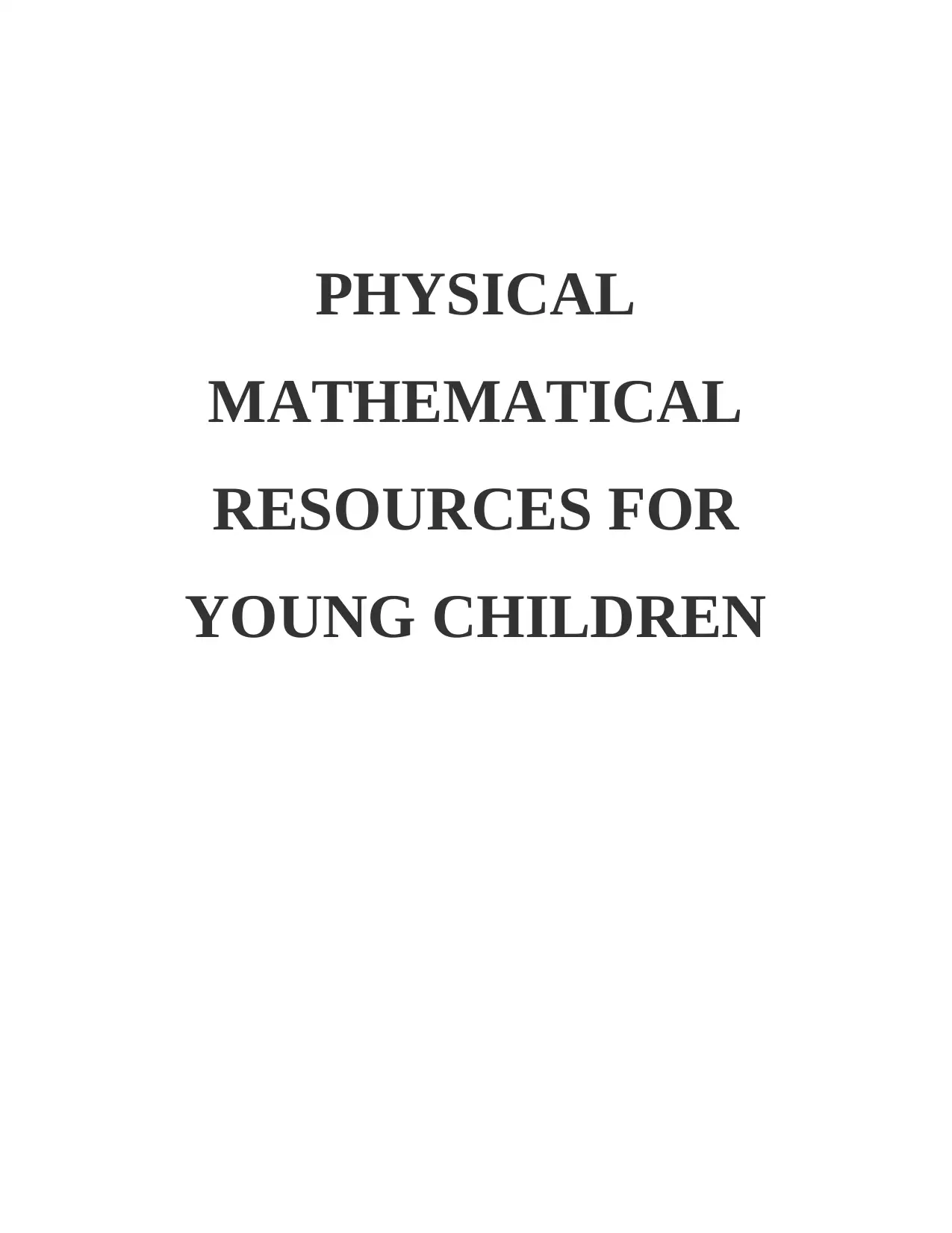
PHYSICAL
MATHEMATICAL
RESOURCES FOR
YOUNG CHILDREN
MATHEMATICAL
RESOURCES FOR
YOUNG CHILDREN
Paraphrase This Document
Need a fresh take? Get an instant paraphrase of this document with our AI Paraphraser
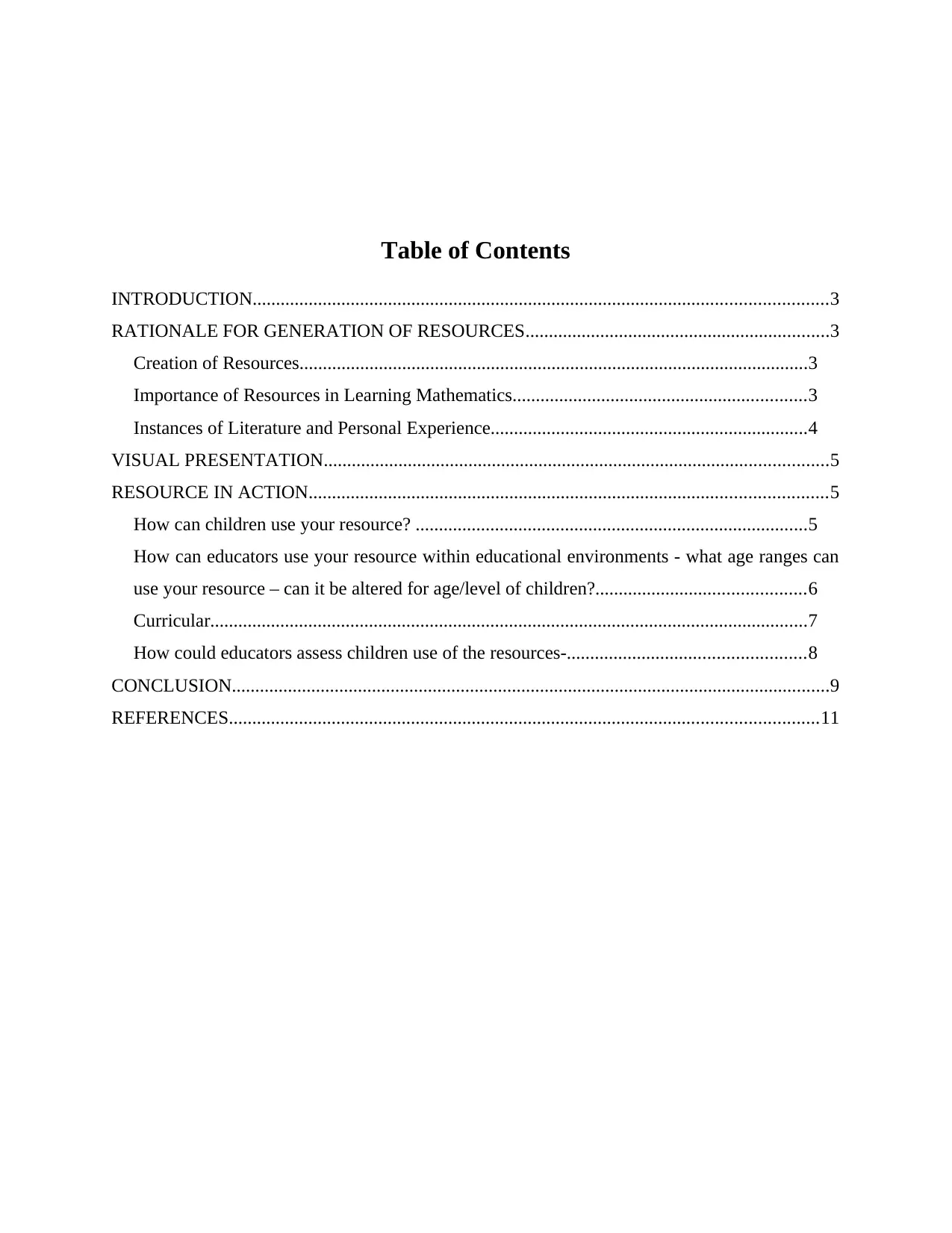
Table of Contents
INTRODUCTION...........................................................................................................................3
RATIONALE FOR GENERATION OF RESOURCES.................................................................3
Creation of Resources.............................................................................................................3
Importance of Resources in Learning Mathematics...............................................................3
Instances of Literature and Personal Experience....................................................................4
VISUAL PRESENTATION............................................................................................................5
RESOURCE IN ACTION...............................................................................................................5
How can children use your resource? ....................................................................................5
How can educators use your resource within educational environments - what age ranges can
use your resource – can it be altered for age/level of children?.............................................6
Curricular................................................................................................................................7
How could educators assess children use of the resources-...................................................8
CONCLUSION................................................................................................................................9
REFERENCES..............................................................................................................................11
INTRODUCTION...........................................................................................................................3
RATIONALE FOR GENERATION OF RESOURCES.................................................................3
Creation of Resources.............................................................................................................3
Importance of Resources in Learning Mathematics...............................................................3
Instances of Literature and Personal Experience....................................................................4
VISUAL PRESENTATION............................................................................................................5
RESOURCE IN ACTION...............................................................................................................5
How can children use your resource? ....................................................................................5
How can educators use your resource within educational environments - what age ranges can
use your resource – can it be altered for age/level of children?.............................................6
Curricular................................................................................................................................7
How could educators assess children use of the resources-...................................................8
CONCLUSION................................................................................................................................9
REFERENCES..............................................................................................................................11
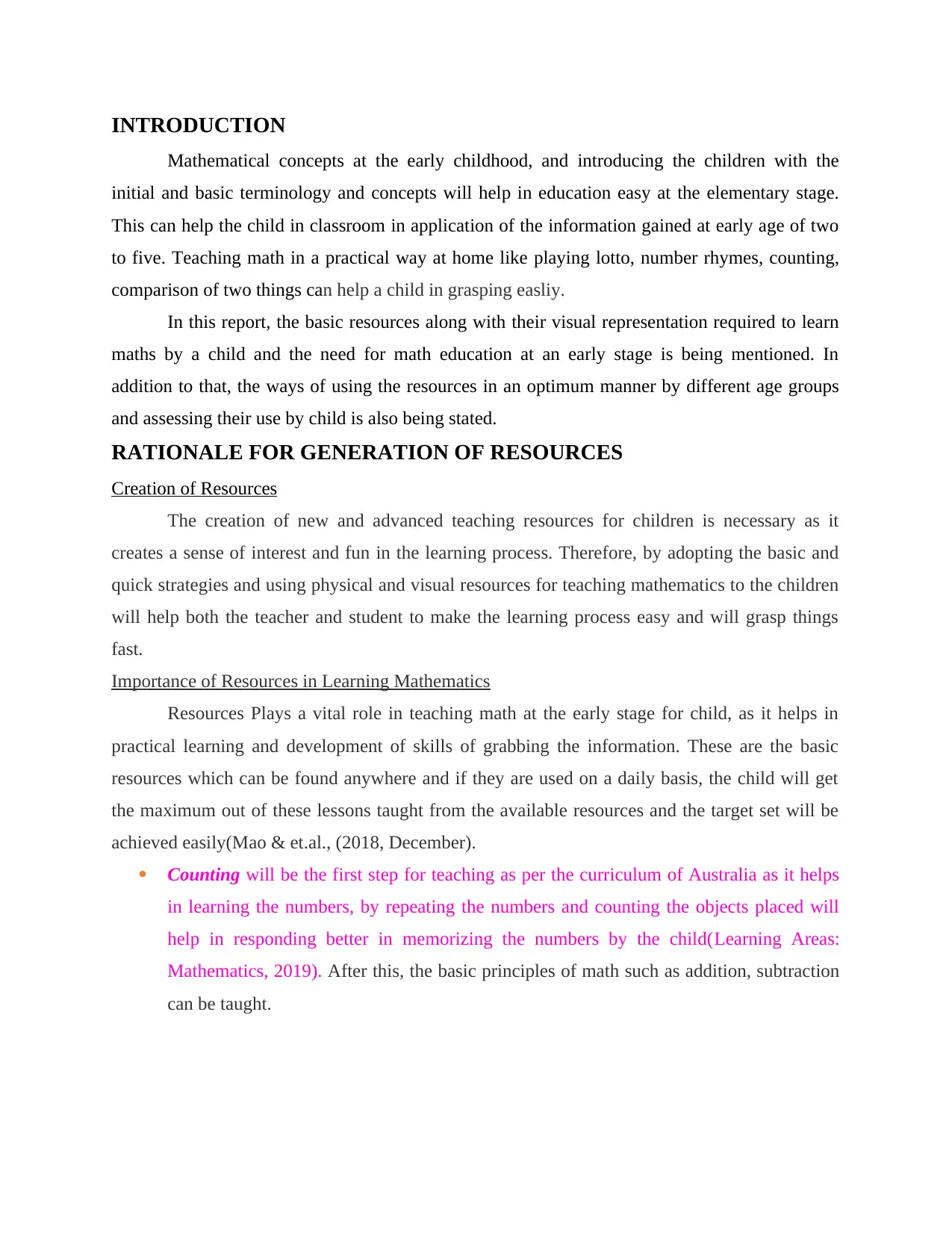
INTRODUCTION
Mathematical concepts at the early childhood, and introducing the children with the
initial and basic terminology and concepts will help in education easy at the elementary stage.
This can help the child in classroom in application of the information gained at early age of two
to five. Teaching math in a practical way at home like playing lotto, number rhymes, counting,
comparison of two things can help a child in grasping easliy.
In this report, the basic resources along with their visual representation required to learn
maths by a child and the need for math education at an early stage is being mentioned. In
addition to that, the ways of using the resources in an optimum manner by different age groups
and assessing their use by child is also being stated.
RATIONALE FOR GENERATION OF RESOURCES
Creation of Resources
The creation of new and advanced teaching resources for children is necessary as it
creates a sense of interest and fun in the learning process. Therefore, by adopting the basic and
quick strategies and using physical and visual resources for teaching mathematics to the children
will help both the teacher and student to make the learning process easy and will grasp things
fast.
Importance of Resources in Learning Mathematics
Resources Plays a vital role in teaching math at the early stage for child, as it helps in
practical learning and development of skills of grabbing the information. These are the basic
resources which can be found anywhere and if they are used on a daily basis, the child will get
the maximum out of these lessons taught from the available resources and the target set will be
achieved easily(Mao & et.al., (2018, December).
Counting will be the first step for teaching as per the curriculum of Australia as it helps
in learning the numbers, by repeating the numbers and counting the objects placed will
help in responding better in memorizing the numbers by the child(Learning Areas:
Mathematics, 2019). After this, the basic principles of math such as addition, subtraction
can be taught.
Mathematical concepts at the early childhood, and introducing the children with the
initial and basic terminology and concepts will help in education easy at the elementary stage.
This can help the child in classroom in application of the information gained at early age of two
to five. Teaching math in a practical way at home like playing lotto, number rhymes, counting,
comparison of two things can help a child in grasping easliy.
In this report, the basic resources along with their visual representation required to learn
maths by a child and the need for math education at an early stage is being mentioned. In
addition to that, the ways of using the resources in an optimum manner by different age groups
and assessing their use by child is also being stated.
RATIONALE FOR GENERATION OF RESOURCES
Creation of Resources
The creation of new and advanced teaching resources for children is necessary as it
creates a sense of interest and fun in the learning process. Therefore, by adopting the basic and
quick strategies and using physical and visual resources for teaching mathematics to the children
will help both the teacher and student to make the learning process easy and will grasp things
fast.
Importance of Resources in Learning Mathematics
Resources Plays a vital role in teaching math at the early stage for child, as it helps in
practical learning and development of skills of grabbing the information. These are the basic
resources which can be found anywhere and if they are used on a daily basis, the child will get
the maximum out of these lessons taught from the available resources and the target set will be
achieved easily(Mao & et.al., (2018, December).
Counting will be the first step for teaching as per the curriculum of Australia as it helps
in learning the numbers, by repeating the numbers and counting the objects placed will
help in responding better in memorizing the numbers by the child(Learning Areas:
Mathematics, 2019). After this, the basic principles of math such as addition, subtraction
can be taught.
⊘ This is a preview!⊘
Do you want full access?
Subscribe today to unlock all pages.

Trusted by 1+ million students worldwide
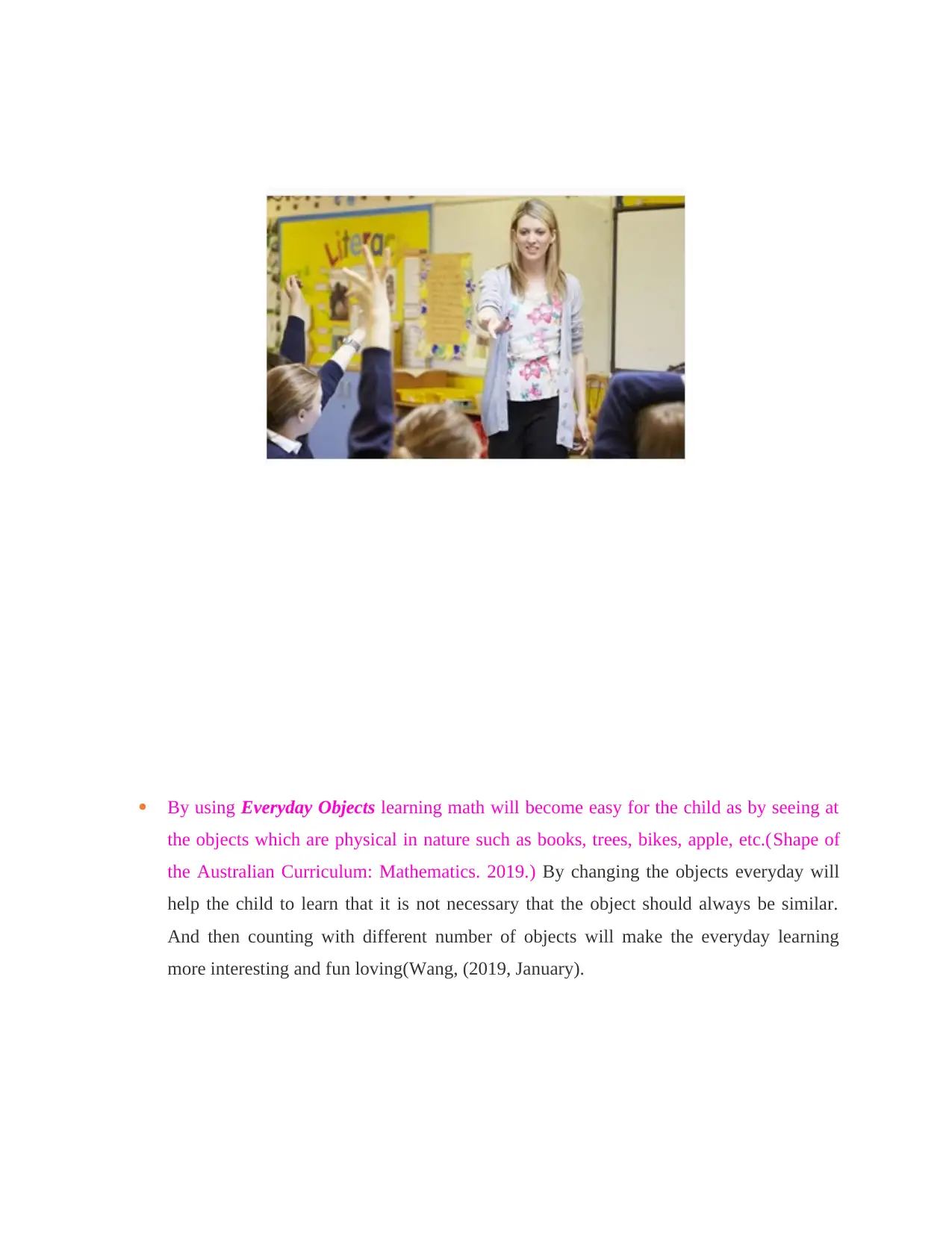
By using Everyday Objects learning math will become easy for the child as by seeing at
the objects which are physical in nature such as books, trees, bikes, apple, etc.(Shape of
the Australian Curriculum: Mathematics. 2019.) By changing the objects everyday will
help the child to learn that it is not necessary that the object should always be similar.
And then counting with different number of objects will make the everyday learning
more interesting and fun loving(Wang, (2019, January).
the objects which are physical in nature such as books, trees, bikes, apple, etc.(Shape of
the Australian Curriculum: Mathematics. 2019.) By changing the objects everyday will
help the child to learn that it is not necessary that the object should always be similar.
And then counting with different number of objects will make the everyday learning
more interesting and fun loving(Wang, (2019, January).
Paraphrase This Document
Need a fresh take? Get an instant paraphrase of this document with our AI Paraphraser
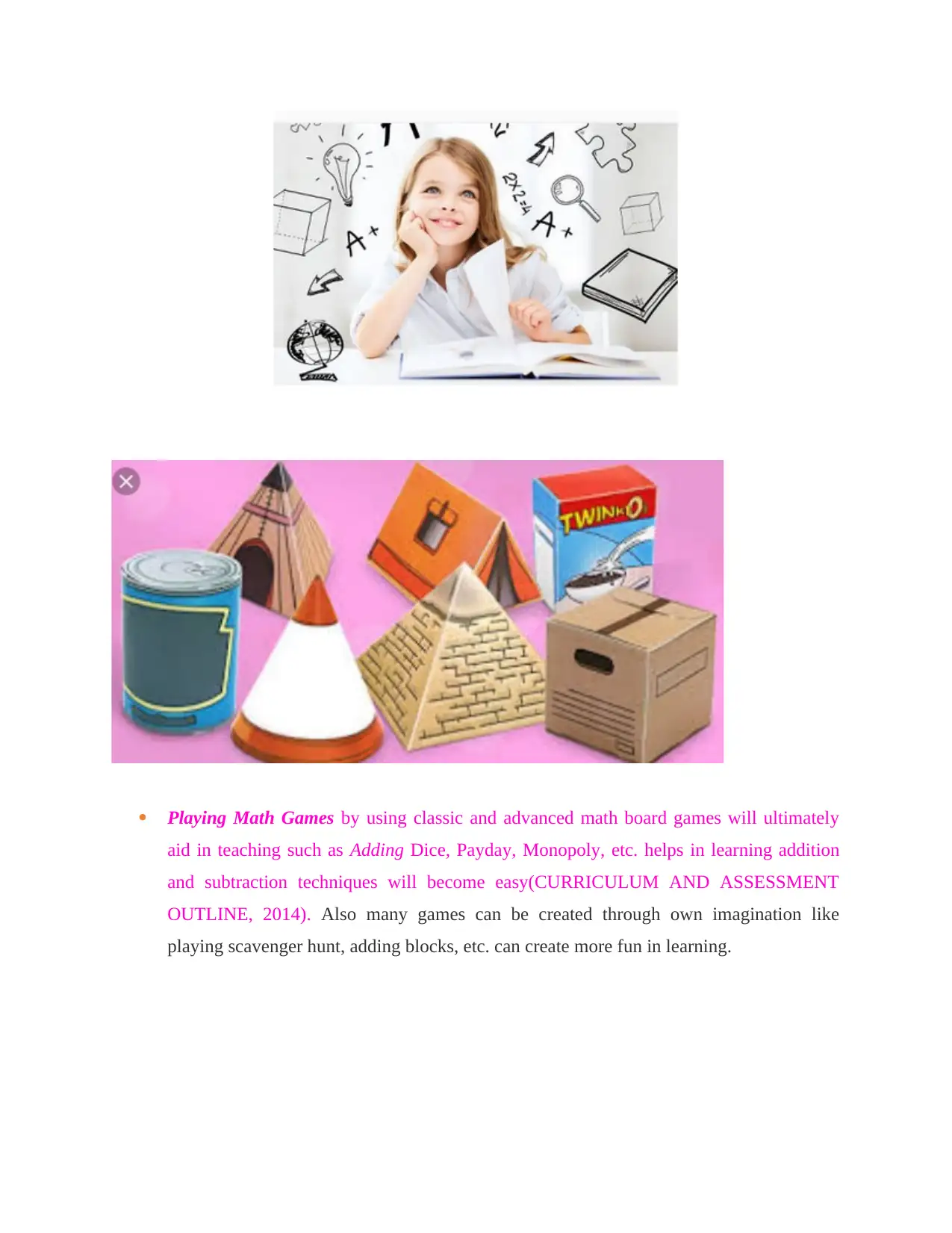
Playing Math Games by using classic and advanced math board games will ultimately
aid in teaching such as Adding Dice, Payday, Monopoly, etc. helps in learning addition
and subtraction techniques will become easy(CURRICULUM AND ASSESSMENT
OUTLINE, 2014). Also many games can be created through own imagination like
playing scavenger hunt, adding blocks, etc. can create more fun in learning.
aid in teaching such as Adding Dice, Payday, Monopoly, etc. helps in learning addition
and subtraction techniques will become easy(CURRICULUM AND ASSESSMENT
OUTLINE, 2014). Also many games can be created through own imagination like
playing scavenger hunt, adding blocks, etc. can create more fun in learning.
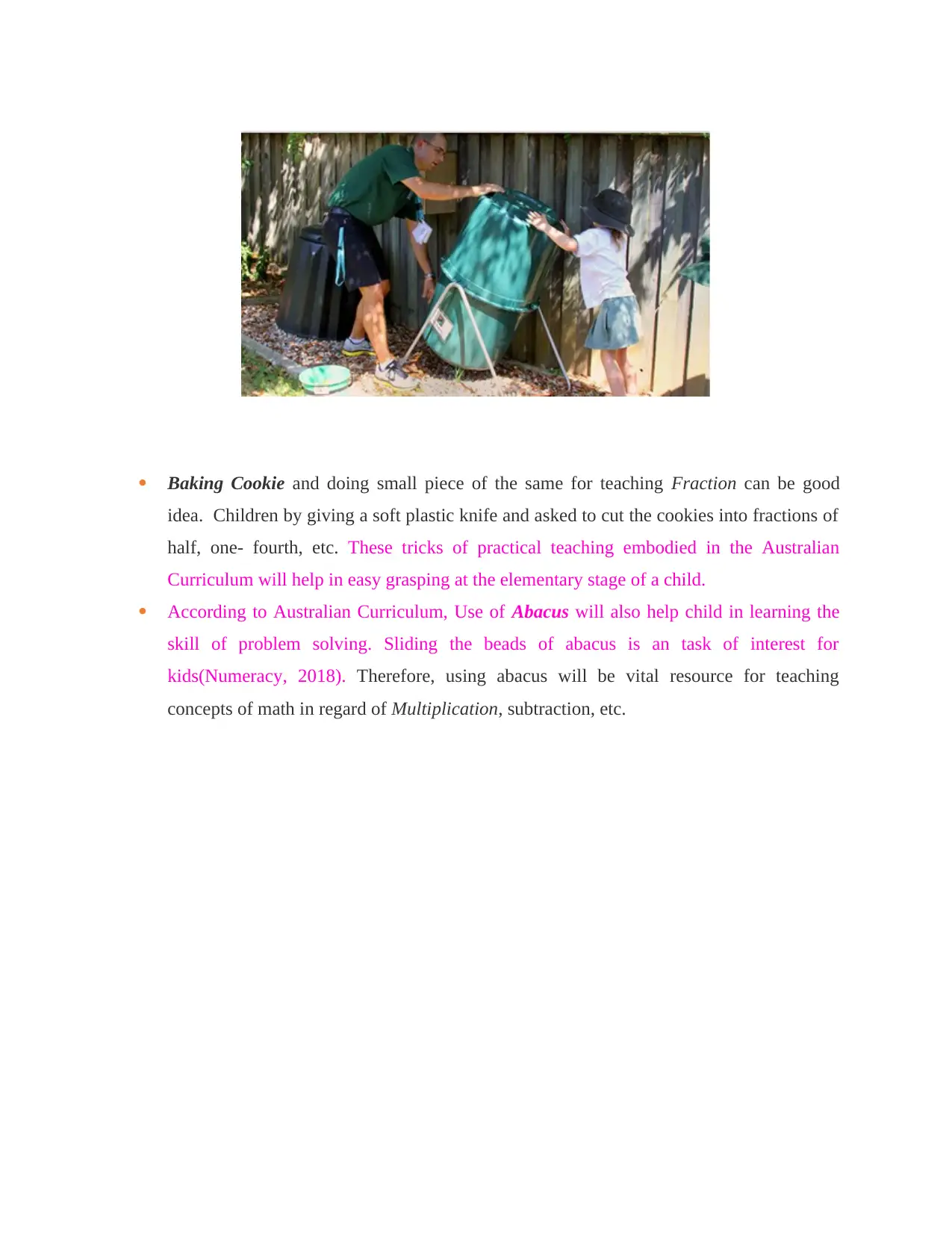
Baking Cookie and doing small piece of the same for teaching Fraction can be good
idea. Children by giving a soft plastic knife and asked to cut the cookies into fractions of
half, one- fourth, etc. These tricks of practical teaching embodied in the Australian
Curriculum will help in easy grasping at the elementary stage of a child.
According to Australian Curriculum, Use of Abacus will also help child in learning the
skill of problem solving. Sliding the beads of abacus is an task of interest for
kids(Numeracy, 2018). Therefore, using abacus will be vital resource for teaching
concepts of math in regard of Multiplication, subtraction, etc.
idea. Children by giving a soft plastic knife and asked to cut the cookies into fractions of
half, one- fourth, etc. These tricks of practical teaching embodied in the Australian
Curriculum will help in easy grasping at the elementary stage of a child.
According to Australian Curriculum, Use of Abacus will also help child in learning the
skill of problem solving. Sliding the beads of abacus is an task of interest for
kids(Numeracy, 2018). Therefore, using abacus will be vital resource for teaching
concepts of math in regard of Multiplication, subtraction, etc.
⊘ This is a preview!⊘
Do you want full access?
Subscribe today to unlock all pages.

Trusted by 1+ million students worldwide
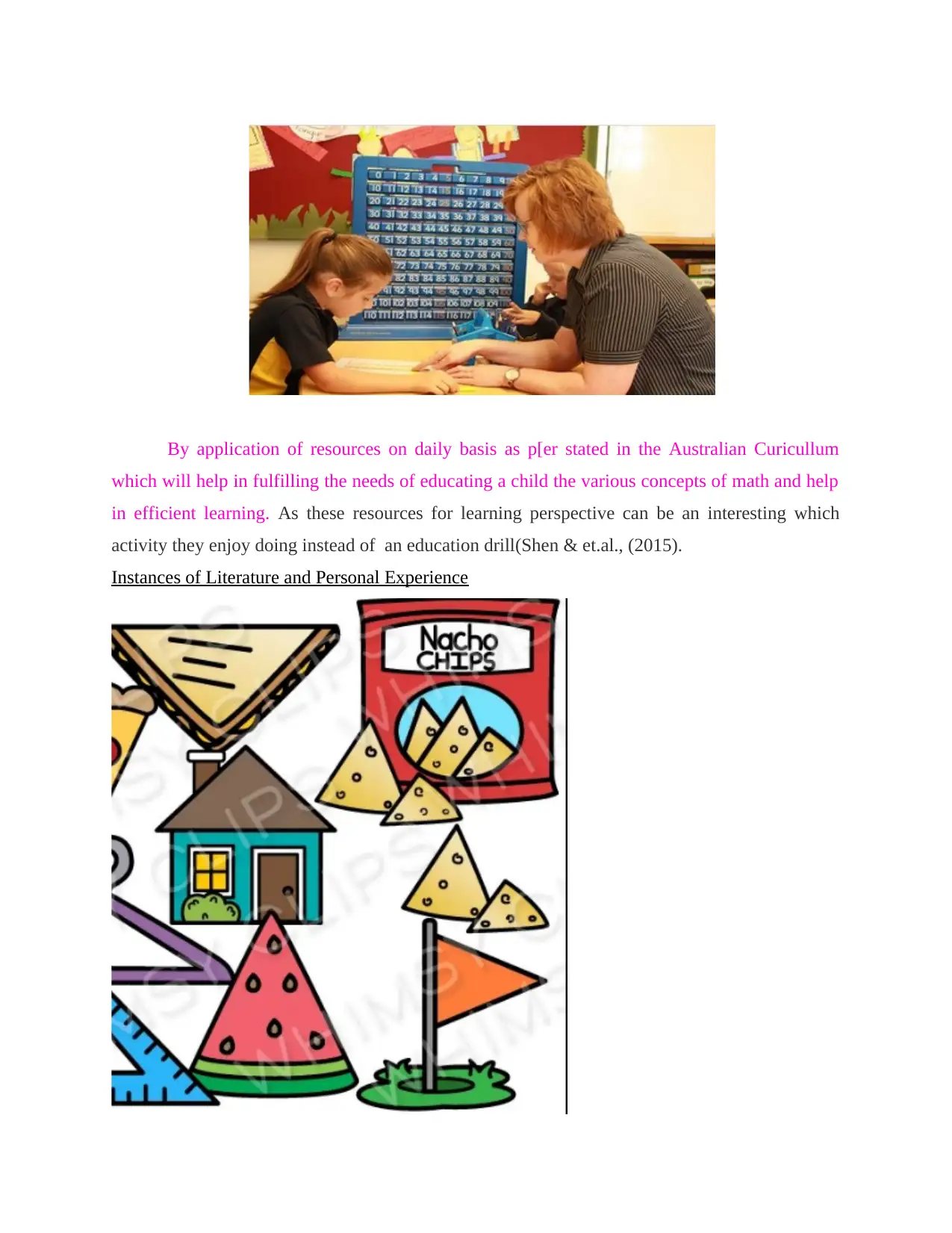
By application of resources on daily basis as p[er stated in the Australian Curicullum
which will help in fulfilling the needs of educating a child the various concepts of math and help
in efficient learning. As these resources for learning perspective can be an interesting which
activity they enjoy doing instead of an education drill(Shen & et.al., (2015).
Instances of Literature and Personal Experience
which will help in fulfilling the needs of educating a child the various concepts of math and help
in efficient learning. As these resources for learning perspective can be an interesting which
activity they enjoy doing instead of an education drill(Shen & et.al., (2015).
Instances of Literature and Personal Experience
Paraphrase This Document
Need a fresh take? Get an instant paraphrase of this document with our AI Paraphraser
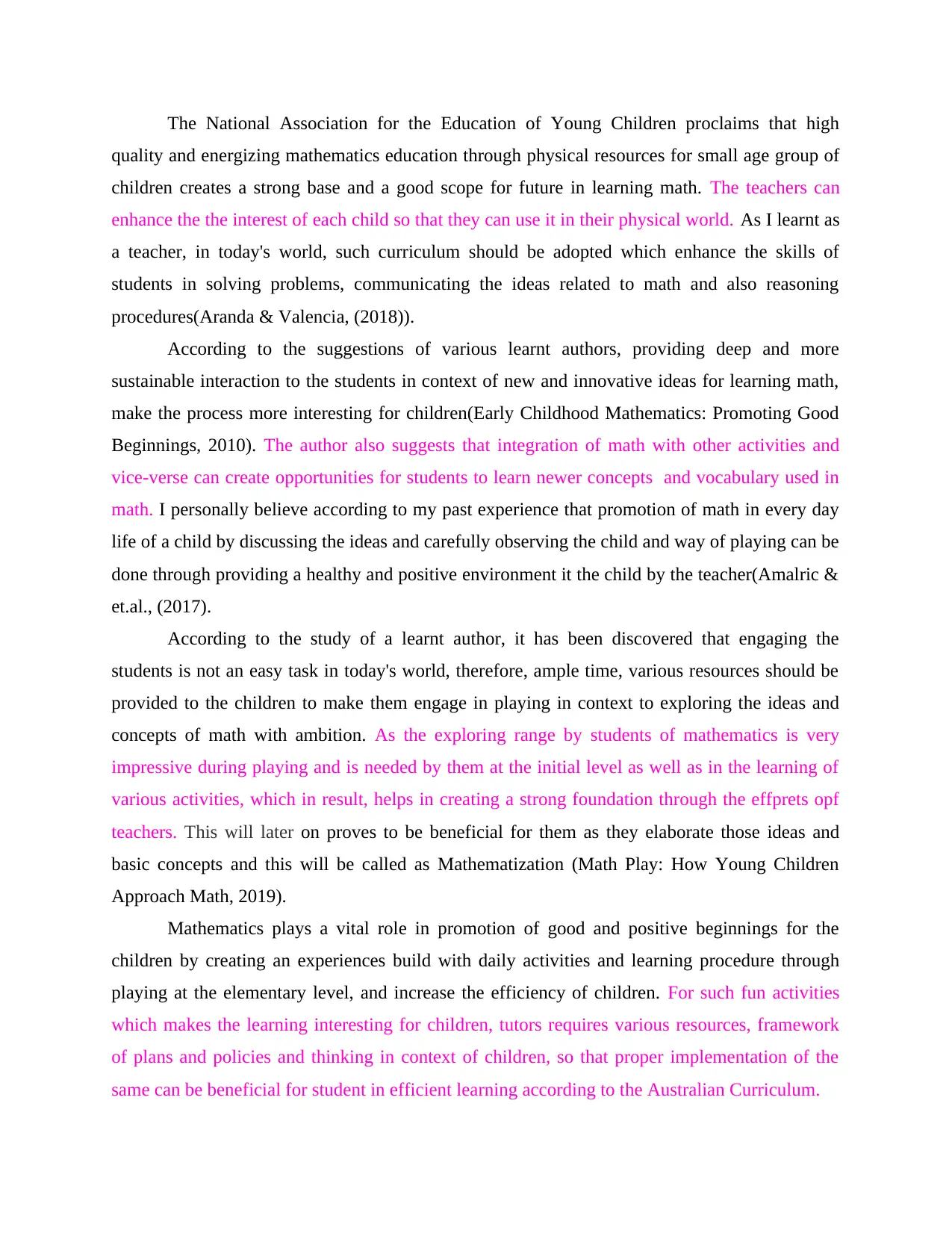
The National Association for the Education of Young Children proclaims that high
quality and energizing mathematics education through physical resources for small age group of
children creates a strong base and a good scope for future in learning math. The teachers can
enhance the the interest of each child so that they can use it in their physical world. As I learnt as
a teacher, in today's world, such curriculum should be adopted which enhance the skills of
students in solving problems, communicating the ideas related to math and also reasoning
procedures(Aranda & Valencia, (2018)).
According to the suggestions of various learnt authors, providing deep and more
sustainable interaction to the students in context of new and innovative ideas for learning math,
make the process more interesting for children(Early Childhood Mathematics: Promoting Good
Beginnings, 2010). The author also suggests that integration of math with other activities and
vice-verse can create opportunities for students to learn newer concepts and vocabulary used in
math. I personally believe according to my past experience that promotion of math in every day
life of a child by discussing the ideas and carefully observing the child and way of playing can be
done through providing a healthy and positive environment it the child by the teacher(Amalric &
et.al., (2017).
According to the study of a learnt author, it has been discovered that engaging the
students is not an easy task in today's world, therefore, ample time, various resources should be
provided to the children to make them engage in playing in context to exploring the ideas and
concepts of math with ambition. As the exploring range by students of mathematics is very
impressive during playing and is needed by them at the initial level as well as in the learning of
various activities, which in result, helps in creating a strong foundation through the effprets opf
teachers. This will later on proves to be beneficial for them as they elaborate those ideas and
basic concepts and this will be called as Mathematization (Math Play: How Young Children
Approach Math, 2019).
Mathematics plays a vital role in promotion of good and positive beginnings for the
children by creating an experiences build with daily activities and learning procedure through
playing at the elementary level, and increase the efficiency of children. For such fun activities
which makes the learning interesting for children, tutors requires various resources, framework
of plans and policies and thinking in context of children, so that proper implementation of the
same can be beneficial for student in efficient learning according to the Australian Curriculum.
quality and energizing mathematics education through physical resources for small age group of
children creates a strong base and a good scope for future in learning math. The teachers can
enhance the the interest of each child so that they can use it in their physical world. As I learnt as
a teacher, in today's world, such curriculum should be adopted which enhance the skills of
students in solving problems, communicating the ideas related to math and also reasoning
procedures(Aranda & Valencia, (2018)).
According to the suggestions of various learnt authors, providing deep and more
sustainable interaction to the students in context of new and innovative ideas for learning math,
make the process more interesting for children(Early Childhood Mathematics: Promoting Good
Beginnings, 2010). The author also suggests that integration of math with other activities and
vice-verse can create opportunities for students to learn newer concepts and vocabulary used in
math. I personally believe according to my past experience that promotion of math in every day
life of a child by discussing the ideas and carefully observing the child and way of playing can be
done through providing a healthy and positive environment it the child by the teacher(Amalric &
et.al., (2017).
According to the study of a learnt author, it has been discovered that engaging the
students is not an easy task in today's world, therefore, ample time, various resources should be
provided to the children to make them engage in playing in context to exploring the ideas and
concepts of math with ambition. As the exploring range by students of mathematics is very
impressive during playing and is needed by them at the initial level as well as in the learning of
various activities, which in result, helps in creating a strong foundation through the effprets opf
teachers. This will later on proves to be beneficial for them as they elaborate those ideas and
basic concepts and this will be called as Mathematization (Math Play: How Young Children
Approach Math, 2019).
Mathematics plays a vital role in promotion of good and positive beginnings for the
children by creating an experiences build with daily activities and learning procedure through
playing at the elementary level, and increase the efficiency of children. For such fun activities
which makes the learning interesting for children, tutors requires various resources, framework
of plans and policies and thinking in context of children, so that proper implementation of the
same can be beneficial for student in efficient learning according to the Australian Curriculum.
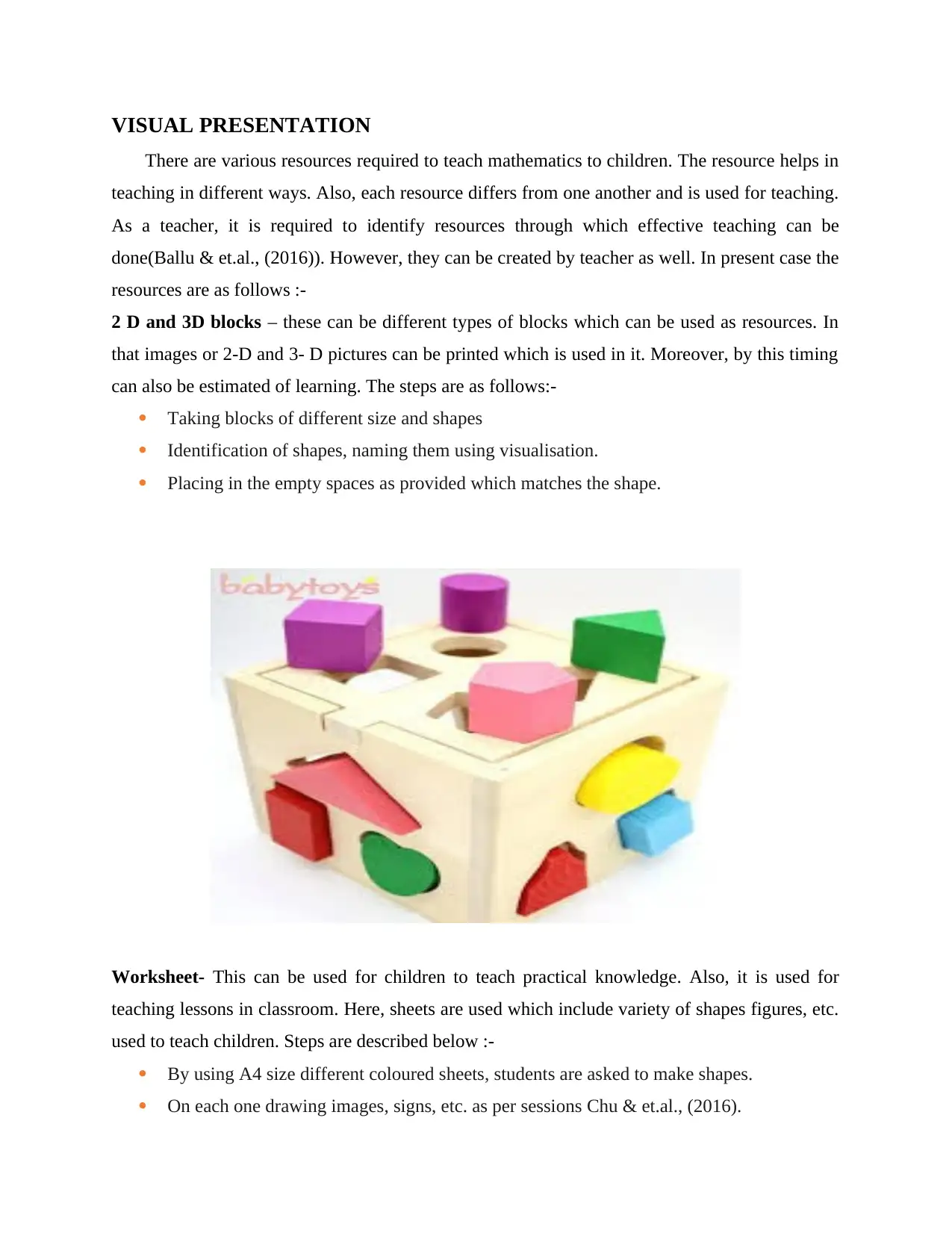
VISUAL PRESENTATION
There are various resources required to teach mathematics to children. The resource helps in
teaching in different ways. Also, each resource differs from one another and is used for teaching.
As a teacher, it is required to identify resources through which effective teaching can be
done(Ballu & et.al., (2016)). However, they can be created by teacher as well. In present case the
resources are as follows :-
2 D and 3D blocks – these can be different types of blocks which can be used as resources. In
that images or 2-D and 3- D pictures can be printed which is used in it. Moreover, by this timing
can also be estimated of learning. The steps are as follows:-
Taking blocks of different size and shapes
Identification of shapes, naming them using visualisation.
Placing in the empty spaces as provided which matches the shape.
Worksheet- This can be used for children to teach practical knowledge. Also, it is used for
teaching lessons in classroom. Here, sheets are used which include variety of shapes figures, etc.
used to teach children. Steps are described below :-
By using A4 size different coloured sheets, students are asked to make shapes.
On each one drawing images, signs, etc. as per sessions Chu & et.al., (2016).
There are various resources required to teach mathematics to children. The resource helps in
teaching in different ways. Also, each resource differs from one another and is used for teaching.
As a teacher, it is required to identify resources through which effective teaching can be
done(Ballu & et.al., (2016)). However, they can be created by teacher as well. In present case the
resources are as follows :-
2 D and 3D blocks – these can be different types of blocks which can be used as resources. In
that images or 2-D and 3- D pictures can be printed which is used in it. Moreover, by this timing
can also be estimated of learning. The steps are as follows:-
Taking blocks of different size and shapes
Identification of shapes, naming them using visualisation.
Placing in the empty spaces as provided which matches the shape.
Worksheet- This can be used for children to teach practical knowledge. Also, it is used for
teaching lessons in classroom. Here, sheets are used which include variety of shapes figures, etc.
used to teach children. Steps are described below :-
By using A4 size different coloured sheets, students are asked to make shapes.
On each one drawing images, signs, etc. as per sessions Chu & et.al., (2016).
⊘ This is a preview!⊘
Do you want full access?
Subscribe today to unlock all pages.

Trusted by 1+ million students worldwide
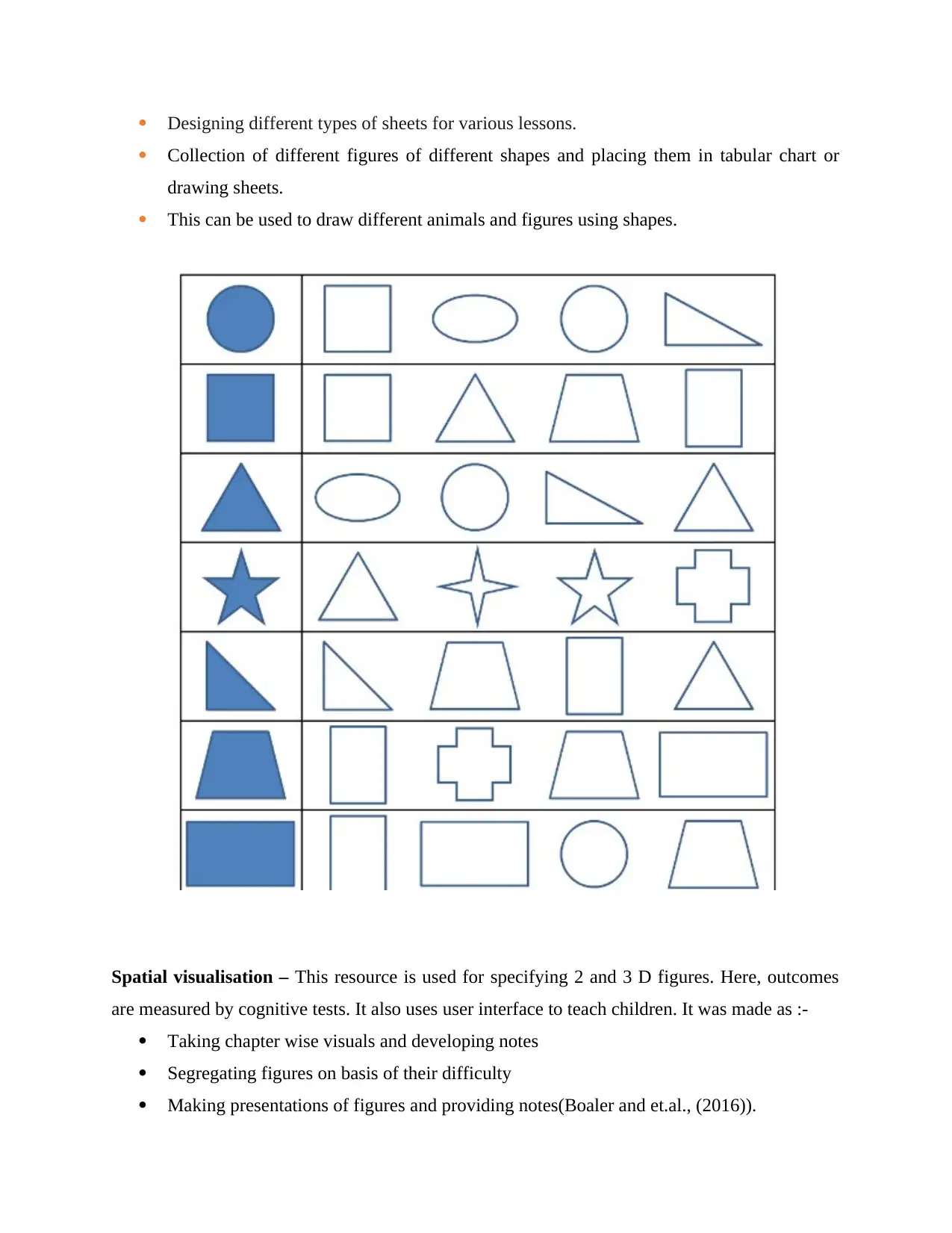
Designing different types of sheets for various lessons.
Collection of different figures of different shapes and placing them in tabular chart or
drawing sheets.
This can be used to draw different animals and figures using shapes.
Spatial visualisation – This resource is used for specifying 2 and 3 D figures. Here, outcomes
are measured by cognitive tests. It also uses user interface to teach children. It was made as :-
Taking chapter wise visuals and developing notes
Segregating figures on basis of their difficulty
Making presentations of figures and providing notes(Boaler and et.al., (2016)).
Collection of different figures of different shapes and placing them in tabular chart or
drawing sheets.
This can be used to draw different animals and figures using shapes.
Spatial visualisation – This resource is used for specifying 2 and 3 D figures. Here, outcomes
are measured by cognitive tests. It also uses user interface to teach children. It was made as :-
Taking chapter wise visuals and developing notes
Segregating figures on basis of their difficulty
Making presentations of figures and providing notes(Boaler and et.al., (2016)).
Paraphrase This Document
Need a fresh take? Get an instant paraphrase of this document with our AI Paraphraser
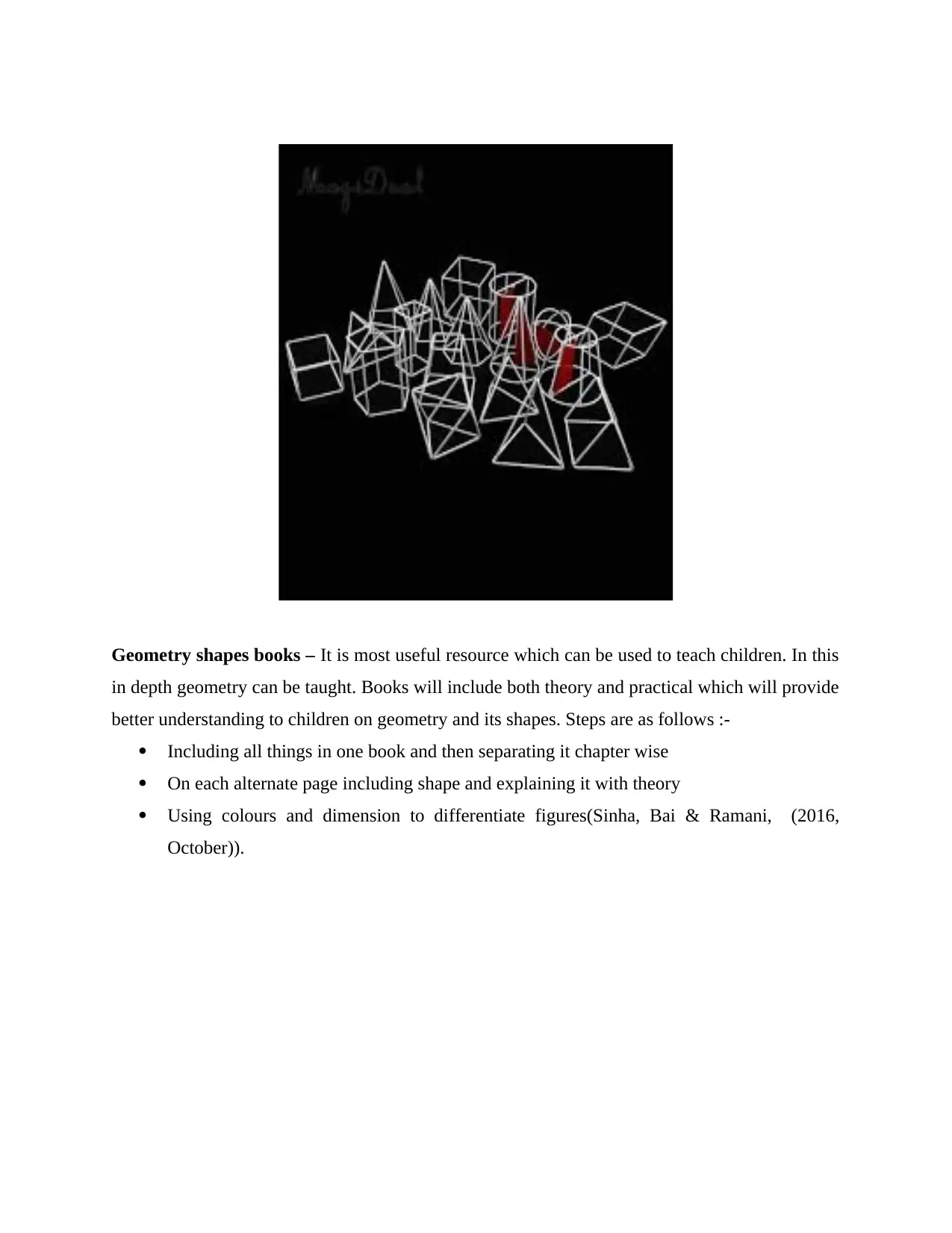
Geometry shapes books – It is most useful resource which can be used to teach children. In this
in depth geometry can be taught. Books will include both theory and practical which will provide
better understanding to children on geometry and its shapes. Steps are as follows :-
Including all things in one book and then separating it chapter wise
On each alternate page including shape and explaining it with theory
Using colours and dimension to differentiate figures(Sinha, Bai & Ramani, (2016,
October)).
in depth geometry can be taught. Books will include both theory and practical which will provide
better understanding to children on geometry and its shapes. Steps are as follows :-
Including all things in one book and then separating it chapter wise
On each alternate page including shape and explaining it with theory
Using colours and dimension to differentiate figures(Sinha, Bai & Ramani, (2016,
October)).

So, these all physical resources will be used to teach geometry to children. It will enable
teacher to use it according to their needs. Furthermore, visual presentation makes it easy to teach
mathematics and clear understanding of figures(Gao, Brodzki & Mukherjee, (2016)).
RESOURCE IN ACTION
Recourse which are used in the study are the shapes and objects which are used by students in
generating the deep learning skills in the students which can provide them an easy learning skills
which are used to evaluate the mathematical learnings and increase the thinking skills, use of
mathematical games which are used for students to frame the learning skills and help the students
in effective learning, baking cookie can help the students to learn shapes which are required to
increase learning skills, abacus helps in the learning of mathematics.
How can children use your resource?
Classroom practice:
Teacher can teach a specific task like geometry shapes and figures which can help them in
learning and developing. Geometry can help students to develop their personal skills which will
help in all round development of the organization which will help students to grow socially and
individually. Children will use these resources by a proper learning methods like analysing the
objects and using their skills and knowledge by relating to the objects of the outer world, relating
teacher to use it according to their needs. Furthermore, visual presentation makes it easy to teach
mathematics and clear understanding of figures(Gao, Brodzki & Mukherjee, (2016)).
RESOURCE IN ACTION
Recourse which are used in the study are the shapes and objects which are used by students in
generating the deep learning skills in the students which can provide them an easy learning skills
which are used to evaluate the mathematical learnings and increase the thinking skills, use of
mathematical games which are used for students to frame the learning skills and help the students
in effective learning, baking cookie can help the students to learn shapes which are required to
increase learning skills, abacus helps in the learning of mathematics.
How can children use your resource?
Classroom practice:
Teacher can teach a specific task like geometry shapes and figures which can help them in
learning and developing. Geometry can help students to develop their personal skills which will
help in all round development of the organization which will help students to grow socially and
individually. Children will use these resources by a proper learning methods like analysing the
objects and using their skills and knowledge by relating to the objects of the outer world, relating
⊘ This is a preview!⊘
Do you want full access?
Subscribe today to unlock all pages.

Trusted by 1+ million students worldwide
1 out of 19
Related Documents
Your All-in-One AI-Powered Toolkit for Academic Success.
+13062052269
info@desklib.com
Available 24*7 on WhatsApp / Email
![[object Object]](/_next/static/media/star-bottom.7253800d.svg)
Unlock your academic potential
Copyright © 2020–2025 A2Z Services. All Rights Reserved. Developed and managed by ZUCOL.




